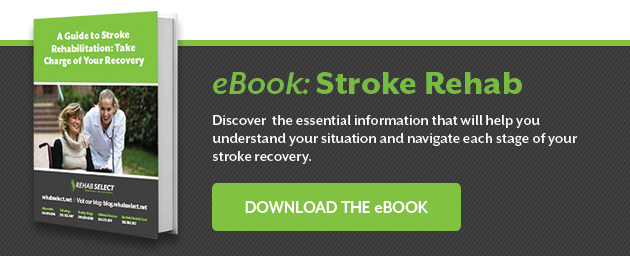
More than 700,000 Americans suffer a stroke every year. Strokes can be devastating — physically, cognitively, and emotionally. The process of recovery may be tough, but physical therapy can be helpful for minimizing symptoms and improving quality of life after a stroke.
Physical therapy for stroke patients works alongside occupational and speech therapies to help with recovery. Depending on the patient’s post-stroke symptoms, some or all of these therapies may be needed. In this article, we’ll take a detailed look at the process of physical therapy for stroke patients, and examine some of the benefits that can result from stroke rehab.
Common Physical Symptoms After Stroke
The term “stroke” describes a medical event in which blood flow to the brain is blocked by a blood clot or failing artery. Strokes are medical emergencies which often cause severe and lasting after-effects. In fact, strokes are one of the leading causes of long-term disability in the US; 40% of stroke patients experience moderate to severe impairments, and 10% will require long-term care in a nursing home. Symptoms can take many forms, but the most common physical side effects of stroke include:
Paralysis
Partial paralysis is common in stroke sufferers. Typically, the paralysis will affect part or all of one side of the body, such as the muscles on one side of the face, one arm or leg.
Muscle weakness
Muscle weakness may affect one or both sides of the body after a stroke and may cause difficulty grasping objects, problems with walking, issues with swallowing, or bowel and/or bladder incontinence.
Seizures and spasticity
Seizures are not uncommon after strokes. Some patients develop chronic seizures, also known as epilepsy. Sudden, uncontrolled muscle movement, known as spasticity, is also a frequent side effect.
Problems with vision
Depending on the location of the stroke in the brain, patients may develop eye issues, including impaired vision, tunnel vision, or blind spots.
Balance issues and ataxia
Many patients experience difficulties with balance, walking and the ability to coordinate movements, otherwise known as ataxia.
All these symptoms are obviously both distressing and disabling. However, with the right treatment, many of them can be improved, and they may even resolve altogether. It can play a key role in helping stroke patients and physical therapy is essential for managing their conditions.
Physical Therapy for Stroke Patients
What is Stroke Physical Therapy?
Physical therapy is a form of rehabilitation treatment that focuses on rebuilding physical strength and mobility through a supervised and structured regime of exercises. Physical therapy treatment of stroke is a major component of post-stroke recovery, focusing on addressing and reducing the physical impact of a stroke.
What Happens During Physical Therapy Treatment of Stroke?
The first stage of post-stroke physical therapy begins in the hospital, often within 1-2 days of the stroke. The physical therapist will work with the patient to encourage autonomous movement, such as changing position in bed. This will build up to passive movements, in which the therapist will help the patient begin to move their arms and legs, or sit up in bed. Finally, the patient will be encouraged to move as much as possible by themselves; depending on the severity of the stroke, they will be invited to get out of bed, support their weight unassisted, or walk around the hospital ward.
After the stroke patient has been discharged from the hospital, they will usually begin a course of more intensive rehab, which will include extensive physical therapy. A licensed physical therapist will design a series of exercises, specifically addressing the patient’s post-stroke side effects. After assessing each individual patient, they will create a rehab regimen that will help to restore as much normal function as possible, focusing on the range of motion, balance, motor control, strength, and endurance.
In cases where the patient has lost the use of an arm or leg during a stroke, the physical therapist may also try to help the patient regain some or full control of the impaired limb, taking advantage of brain plasticity to reduce disabilities where possible.
Programs will be designed to guide the patient through complex movements, such as walking up and down stairs. There will also usually be a series of repetitive exercises on isolated muscle groups, to regain muscle control and build strength and flexibility.
Benefits of Physical Therapy After Stroke
Physical rehab has been shown to have beneficial results after a stroke.
“Stroke patients will have some natural recovery without rehab, but there is quite a bit of evidence that formal rehabilitation helps patients recover faster and better than they would otherwise,” comments Dr. E.S. Claflin of the University of Michigan.
Key benefits of physical therapy after a stroke include:
Improved overall strength and mobility
While strokes can be physically devastating, a dedicated and consistent exercise regime can make a big difference. Although every stroke is different, and outcomes vary from patient to patient, people receiving rehab after a stroke will be more likely to gain strength and agility over time and should become increasingly able to return to daily life.
Preventing muscle atrophy
Stroke patients who have lost the use of a limb or limbs run the risk of muscle atrophy - unused muscle weaken and begin to fail over time. Physical therapy can help restore the use of the impaired limb through repeated exercises which both stimulate the muscles and rebuild the brain-body connection.
Better quality of life
Building up physical strength, flexibility, and endurance not only improves overall health, it also makes it easier for stroke patients to return to their everyday lives and perform more of their usual day-to-day tasks.
More independence
Many patients who complete physical therapy after a stroke find that their physical symptoms have improved. They may have better balance, stronger muscles, increased mobility, and a stronger grip. As a result, they may well also feel more confident and be less reliant on their caregivers.
Better mood
Strokes are usually highly traumatic, and in some cases can trigger post-stroke depression and other mood conditions. By helping the patient address their physical issues, reduce their dependence on others, and restore more of their normal function, physical therapy can help patients feel happier and more positive.
Physical Therapy Treatment of Stroke in Alabama
Physical therapy is a critical component of post-stroke rehabilitation and can help to speed up the lengthy and sometimes frustrating process of recovering from a stroke. Rehab Select offers best-in-class stroke rehab services at our Alabama-based facilities. Schedule a tour today to find out more.





